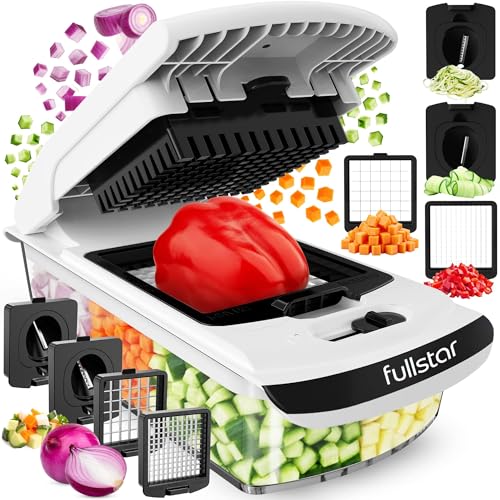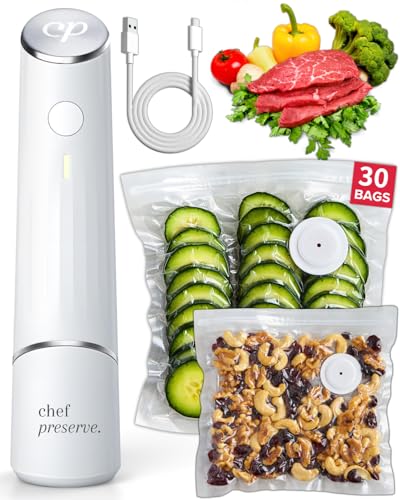Culinary Origins of Bread
Although bread has evolved in various forms across cultures, its origins can be traced back thousands of years to the ancient civilizations of Mesopotamia and Egypt, where the first evidence of leavened bread was discovered.
This ancient staple quickly became integral to diets, fostering a rich bread history that highlights its significance. As societies flourished, so did regional variations; different cultures adapted ingredients and techniques suited to their environments.
In Europe, crusty sourdoughs emerged, while in Asia, flatbreads like naan became popular. Each type of bread carries stories of tradition, necessity, and innovation, reflecting local resources and culinary practices.
The evolution of bread remains a testament to human creativity and the enduring quest for nourishment and flavor.
- The Original Pro Chopper - Our superstar veggie slicer has been creating waves on TikTok! Simple to use,...
- Easy Meal Prep with Rust-Resistant Blades - Our vegetable chopper is perfect for anyone who wants to eat...
- 5-Star Design - The soft-grip TPU handle ensures controlled chopping, while the non-skid rubber base...
Home Bakers Seeking Flavor
As the story of bread continues to unfold, home bakers today embrace the rich tapestry of flavors that can be woven into their creations.
These culinary enthusiasts explore various flavor enhancements, employing innovative baker techniques to elevate their loaves.
Bread experiments abound, with herb combinations like rosemary mingling harmoniously with olive oil, infusing richness into every bite.
Seasonal pairings also play a crucial role; bakers incorporate fresh spring herbs or citrus zest to reflect the essence of the season.
Flavor influences from different cuisines inspire unique adaptations, allowing traditional recipes to bloom with creativity.
- Makes Everything Simple : Just forget your bagged cheese! Only turn the handle for several times and get...
- Premium Material : All parts of the rotary cheese grater are made of food grade ABS material, no BPA. The...
- Three Option Grater : The parmesan cheese grater finishes food preparation with slicing, shredding and...
Essential Ingredients

At the heart of every successful bread lies a carefully curated selection of essential ingredients. For the fragrant Easter Rosemary Olive Oil Bread, the star components are fresh rosemary and high-quality olive oil.
Rosemary, with its aromatic presence, not only infuses the bread with a delightful herbal note but also offers numerous health benefits, including anti-inflammatory and antioxidant properties. Olive oil, known for its rich flavor and smooth texture, enhances the dough’s moisture and contributes to a crispy crust.
Together, these ingredients create a harmonious blend that elevates the bread from ordinary to extraordinary. Additional staples like flour, yeast, and salt provide structure and balance, ensuring this bread is both delectable and satisfying.
- 💰 REDUCE WASTE AND SAVE MONEY: Chef Preserve keeps FOOD FRESH 5 TIMES LONGER than non-vacuum storage...
- ✅ POWERFUL, QUICK & EASY TO USE: Simply press the button to start. The device vacuum seals a bag in 5...
- ♻️ REUSABLE & RESEALABLE BAGS: Chef Preserve comes with dishwasher, freezer, refrigerator, and...
Cooking Steps
Gathering the essential ingredients, the process of making Easter Rosemary Olive Oil Bread unfolds with a blend of warmth and creativity. This beloved recipe reflects Easter traditions, where breaking bread symbolizes unity and renewal.
The first step involves creating a harmonious environment, infusing the kitchen with the aroma of rosemary and olive oil. As the dough comes together, the rhythmic kneading embodies the spirit of togetherness associated with festive gatherings.
Gently shaped into a loaf, it is left to rise, transforming the simple ingredients into a fluffy masterpiece. The anticipation builds as the bread bakes, its crust turning golden and crispy.
This bread not only serves as a delicious accompaniment to Easter feasts, but also represents hope, heritage, and joyful celebration.
- Generous Capacity: 7-quart slow cooker that comfortably serves 9+ people or fits a 7-pound roast
- Cooking Flexibility: High or low slow cooking settings, with convenient warm function for ideal serving...
- Convenient: Set it and forget it feature enables you to cook while at work or performing daily tasks
1. Mix Flour and Salt

Before embarking on the transformation of simple ingredients into a delightful Easter Rosemary Olive Oil Bread, mixing flour and salt lays the essential foundation.
The choice of flour types is crucial, with all-purpose flour being the most common. However, integrating bread flour can enhance the bread’s structure and chewiness, while whole wheat flour adds a nutty flavor and extra nutrition.
In parallel, selecting the right salt varieties can elevate the overall taste. Sea salt, with its subtle mineral notes, complements the bread beautifully, while kosher salt offers a milder seasoning.
Careful measurement ensures a balanced blend, enabling the flavors to marry harmoniously. This mixture forms the backbone of the dough, setting the stage for the layered flavors that will follow in this aromatic bread-making journey.
- 100% Leak-proof: Guaranteed no-spill seal and secure latches
- Crystal-clear Tritan Built: Stain-resistant and odor-resistant material for a clear view of contents
- Lightweight & Sturdy: Easy to carry, yet durable for everyday use
2. Add Olive Oil Gradually

Gently pouring olive oil into the flour and salt mixture transforms the dry ingredients into a rich, flavorful base for the Easter Rosemary Olive Oil Bread. This process, characterized by gradual incorporation, ensures that the oil evenly disperses, enhancing texture and moisture.
As the oil is added, its silky, golden hue glides through the mixture, awakening the ingredients with its robust, aromatic essence. The benefits of olive oil—known for its heart-healthy properties and vibrant flavor—become evident as it melds seamlessly into the dough. Each drop enriches the bread, promising a delightful crust and tender crumb.
This careful addition is crucial, as rushing the process may compromise the balance and character of the bread, undermining its overall quality.
- 𝗘𝗳𝗳𝗼𝗿𝘁𝗹𝗲𝘀𝘀 𝗪𝗲𝗶𝗴𝗵𝗶𝗻𝗴: Supports 5 units...
- 𝗣𝗿𝗲𝗰𝗶𝘀𝗲 𝗥𝗲𝘀𝘂𝗹𝘁𝘀: Accurately weighs up to 11 lb/5 kg with 1 g...
- 𝗦𝗶𝗺𝗽𝗹𝗲 & 𝗖𝗼𝗺𝗽𝗮𝗰𝘁: The small and sleek scale is a perfect fit for...
3. Knead Dough Until Smooth

As the olive oil melds with the dry ingredients, the next crucial step unfolds: kneading the dough until it becomes smooth and elastic.
Proper kneading techniques are essential to develop the gluten structure, which contributes to the bread’s final texture.
Using the palms to push the dough away, then folding it back over itself creates a rhythmic motion that enhances the dough consistency. After about ten minutes, the dough transforms from a rough mixture into a silky ball that springs back when poked.
It is important to avoid excessive flour, which can lead to dryness. The baker’s intuition plays a significant role, ensuring the dough feels just right—soft yet resilient, primed for the next phase in the baking journey.
- Instant Read Food Thermometer | Our instant read thermometer features a temperature probe and advanced,...
- Multi-Use | From bbq thermometer to baking thermometer, our digital food thermometer for cooking is...
- Easy-Read Digital Thermometer For Cooking | Large instant thermometer dial with bright blue backlight...
4. Let Dough Rise in Warmth

How does one ensure the dough rises beautifully?
To achieve perfectly risen dough, it is essential to provide a warm environment that promotes yeast activation. Placing the dough in a cozy spot, such as an oven with the light on or a sunlit kitchen corner, enhances the rising process.
The ideal temperature for the dough often hovers around 75°F to 85°F, where the yeast thrives and works its magic, producing gas bubbles that create a light, airy texture.
Covering the dough with a damp cloth or plastic wrap helps retain moisture while preventing a crust from forming. As the minutes tick by, the dough transforms into a pillowy mass, ready for the next step in the bread-making journey.
- Versatile 54-Piece Collection: Elevate your kitchen with the Home Hero 54-Piece Kitchen Utensil Set, a...
- Durable and Long-Lasting: Crafted from premium stainless steel, these kitchen utensils are designed to...
- Perfect Holiday Gift: Delight your loved ones with this kitchen utensils gift set this festive season....
5. Shape Dough Into Loaf

The dough, having risen beautifully, is now ready to be shaped into a loaf.
The baker begins by gently pressing down on the dough to release excess air, a crucial step in mastering dough techniques.
With floured hands, they fold the edges of the dough into the center, creating a taut skin on the outer surface.
As the dough is turned over, its smoothness becomes apparent, enhancing the final texture.
Carefully, the baker rolls the dough tightly, ensuring it retains its shape during proofing.
This loaf shaping technique not only contributes to the aesthetic appeal but also promotes even baking.
It is now poised to rise again, awaiting the warmth of the oven for its final transformation into delicious Easter bread.
- 24-ounce insulated stainless-steel water bottle with a FreeSip spout and push-button lid with lock
- Patented FreeSip spout designed for either sipping upright through the built-in straw or tilting back to...
- Protective push-to-open lid keeps spout clean; convenient carry loop doubles as a lock
6. Preheat Oven to 375°F

Preheating the oven to 375°F is a critical step in preparing the Easter Rosemary Olive Oil Bread for baking. This specific oven temperature ensures a perfectly balanced baking process, allowing the bread to develop a delightful crispy crust while maintaining a soft, flavor-infused interior.
As the heat permeates the oven, it creates an environment ideal for activating the yeast, which is essential for achieving the desired rise and texture. It is advisable to allow ample preheating time before placing the shaped dough inside, optimizing the baking time for best results.
A properly preheated oven not only contributes to the bread’s overall flavor but also helps achieve that sought-after golden-brown hue, making it a feast for both the eyes and the palate.
7. Accompany With Flavorful Spreads

What could enhance the delightful experience of enjoying freshly baked Easter Rosemary Olive Oil Bread more than a selection of flavorful spreads?
Pairing this fragrant bread with a variety of herb dips elevates its aromatic profile, providing a refreshing contrast to its crispy crust. Vibrant basil and zesty cilantro herb dips bring a burst of freshness, harmonizing beautifully with the rosemary notes.
Additionally, creamy cheese spreads, such as tangy goat cheese or rich herbed cream cheese, offer a decadent touch, inviting a delightful creaminess that complements the bread’s heartiness.
This array of spreads invites creativity and allows for a personalized experience, ensuring every bite is a celebration of flavors and textures that enhance the enjoyment of this delightful Easter bread.
Serving and Pairing Suggestions

As the aroma of freshly baked Easter Rosemary Olive Oil Bread fills the air, serving it warm alongside a selection of accompaniments transforms a simple meal into an inviting culinary experience.
To elevate this delightful bread, consider pairing it with:
- Herbed olive oil for a fragrant dipping sauce that complements the rosemary notes.
- Balsamic vinegar with honey to offer a sweet yet tangy contrast that enhances the bread’s flavor.
- Creamy goat cheese for a luscious texture that contrasts beautifully with the crispy crust.
- Fruity white or light red wines that seamlessly balance the bread’s earthy undertones, providing an exquisite dining experience.
These thoughtful pairings highlight the bread’s unique characteristics, making every bite memorable.
Tips and Variations

Enhancing the Easter Rosemary Olive Oil Bread can transform it into a personalized masterpiece tailored to individual tastes.
To explore creative variations, one can consider the following tips:
- Herb Variations: Experiment with other aromatic herbs like thyme, basil, or oregano for a unique flavor twist.
- Gluten Free Options: Substitute traditional flour with a gluten-free blend, ensuring everyone can enjoy this delightful bread.
- Cheese Infusion: Incorporate shredded cheese, such as Parmesan or feta, to add richness and depth to the flavor profile.
- Nuts and Seeds: Add walnuts or sunflower seeds for a delightful crunch that complements the soft texture.
These adaptations not only elevate the bread but also invite connections around the table, making every bite memorable.
Kitchen Tools
A well-equipped kitchen can make all the difference when preparing Easter Rosemary Olive Oil Bread. Essential kitchen gadgets and baking accessories allow for seamless preparation and enhance the overall baking experience. A sturdy mixing bowl is vital for combining ingredients, while a measuring scale ensures precise quantities. A bench scraper aids in kneading, and a baking stone can create a delightful crispy crust.
| Kitchen Gadgets | Baking Accessories |
|---|---|
| Mixing Bowl | Baking Stone |
| Measuring Scale | Parchment Paper |
| Bench Scraper | Bread Loaf Pan |
| Cooling Rack | Oven Thermometer |
With these essential tools at hand, any home baker can achieve mouthwatering results, inviting the delicious aroma of rosemary and olive oil into their home.
Essential Equipment
Creating the perfect Easter Rosemary Olive Oil Bread requires not only the right ingredients but also a selection of essential equipment that supports every step of the baking process.
The right baking tools can elevate this fragrant bread, ensuring a delightful texture and flavor. Among the must-have items are:
- A quality mixing bowl for combining ingredients effortlessly.
- A sturdy measuring cup to guarantee precise ingredient ratios.
- A baking stone or baking sheet to achieve that desirable crispy crust.
- A sharp serrated knife for slicing through the baked loaf without crushing it.
These essential gadgets work harmoniously, transforming a simple recipe into a heartfelt creation, best enjoyed with loved ones during festive gatherings.
Nutritional Information (Estimated, per serving)
Each serving of the Easter Rosemary Olive Oil Bread offers a delightful balance of flavors and nourishment, making it a perfect addition to any festive table. This bread not only tantalizes the palate but also provides nutritional benefits. With a moderate calorie count, it allows for indulgence without guilt.
| Nutrient | Amount per Serving |
|---|---|
| Calories | 150 |
| Total Fat | 5g |
| Carbohydrates | 22g |
| Protein | 3g |
| Fiber | 1g |
The olive oil contributes healthy fats, while the rosemary enhances digestion and flavor. This harmonious blend makes every bite both wholesome and flavorful, enriching any meal with essential nutrients and aromatic charm.
Herb-Infused Breads Collections

Herb-infused breads offer a delightful exploration of flavors, elevating the everyday loaf into a culinary experience.
The careful selection of herb varieties and their unique flavor profiles enchant the senses, encouraging bakers to experiment with diverse ingredient combinations.
- Thyme and Garlic: A savory pairing that enhances rustic dishes.
- Basil and Parmesan: A tribute to Italian cuisine, perfect for dipping.
- Sage and Walnut: An earthy blend, excellent for autumn gatherings.
- Rosemary and Olive Oil: A fragrant classic that brings sophistication.
Innovative baking techniques, such as incorporating herbs into the dough or topping loaves with fresh sprigs, can transform the humble bread, inviting warmth and comfort into any home.
Troubleshooting
When baking rosemary olive oil bread, it is essential to anticipate potential challenges that may arise, ensuring a successful outcome.
Achieving the right dough consistency is crucial; too sticky dough may require additional flour, while overly dry dough can benefit from extra olive oil or water.
Monitoring fermentation is also vital; under-proofed dough yields a dense loaf, while over-proofed bread can collapse.
For the desired crust texture, a preheated baking surface and steam during the initial baking phase are recommended. If the crust is too hard, a lower baking temperature could be helpful, while an overly soft crust may indicate insufficient baking time.
Conclusion
Although baking rosemary olive oil bread may present its challenges, the journey culminates in a rewarding experience that delights the senses. This aromatic bread embodies not just culinary skill but also rich bread symbolism deeply woven into various holiday traditions.
Easter, a time of renewal and hope, is beautifully complemented by the act of baking this unique loaf, which adds warmth and togetherness to festive gatherings. The fragrant notes of rosemary combined with the golden, crispy crust evoke memories of shared meals and cherished family moments.
Ultimately, preparing this bread transcends mere nourishment; it becomes a heartfelt expression of love, making it an essential part of celebrating Easter and nurturing connections with loved ones.
















